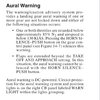I was looking at the salvage aircraft offerings and came across this 2013 Cessna 510. Cause of accident is:
On December 1, 2021 the pilot forgot to lower the landing gear prior to landing at the Lake Havasu City Airport (KHII)
What warning system does this airplane have to prevent this error and aid the single pilot?
On December 1, 2021 the pilot forgot to lower the landing gear prior to landing at the Lake Havasu City Airport (KHII)
What warning system does this airplane have to prevent this error and aid the single pilot?


